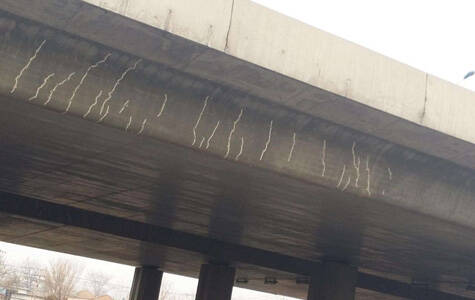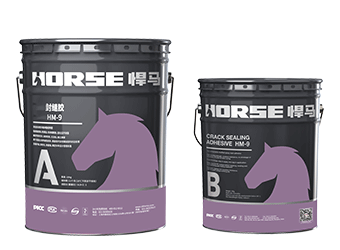Solutions
Horse Construction offers full range of structural strengthening materials with technical supports, documentation supports, products supports, project supports.
Cracks in concrete structures are inevitable, and the load at which cracks appear is often 15% -25% of the ultimate load.

The problem of cracks is a widely concerned issue, and the existence of cracks is a very common phenomenon in concrete structures. A large amount of scientific research and practice have proven that cracks in concrete structures are inevitable, and the load when cracks appear is often 15% -25% of the ultimate load.
Under normal load conditions, reinforced concrete structures generally work with cracks, with visible cracks ranging from 0.02-0.05mm. Cracks with a width less than 0.05mm are considered harmless and have negligible effects on waterproofing, corrosion resistance, and load-bearing capacity.
The current standard for controlling the maximum crack width of concrete structural components under normal usage conditions is 0.3mm. Therefore, from an economic and scientific perspective, a certain degree of cracks is acceptable.
But some cracks can cause a decrease in the structural load-bearing capacity and a decrease in the reliability of the structure; Although some may not have a significant impact on the bearing capacity, issues such as the detachment of the protective layer on the concrete, accelerated corrosion of steel bars, and carbonation of concrete can occur, reducing the durability of the structure or causing leakage, which can affect its use.
When the crack width reaches a certain value, it may also endanger the safety of the structure. Therefore, how to evaluate, identify, and repair cracks in concrete structures is of great practical significance for the use and maintenance of the structure.
Reasons and types of cracks
The causes of crack formation are generally divided into two categories: structural cracks and non structural cracks.
Structural cracks refer to cracks caused by various static and dynamic loads applied directly. The characteristic of structural failure is caused by insufficient load-bearing capacity and stress reaching the limit value. This type of crack is quite dangerous, and if not treated properly, it will pose a safety hazard to the structure.
Non structural cracks are cracks caused by indirect effects such as temperature changes, shrinkage, and uneven settlement, which constrain the deformation of the structure. This type of crack has little impact on the structural bearing capacity and can be repaired according to the requirements of structural durability, impermeability, seismic resistance, and usage.
In actual engineering structures, cracks caused by loads account for only about 20% of the total number, while cracks caused by indirect effects account for approximately 80% of the total number of cracks.
The causes of cracks are complex, and their impact on the structure varies greatly. Only by understanding the structural stress state and the impact of cracks on the structure can corresponding repair measures be determined.
Crack investigation and analysis
The investigation of crack causes includes investigations into aspects such as material and construction quality, design calculation and construction, and usage environment and load, providing a basis for crack analysis.
Determine whether the cracks are structural or non structural through observation of their current condition and investigation of their causes.
Cracks that maintain a constant width and length are considered stable cracks. As long as their width is not large, they meet regulatory requirements, and their danger is low, they are considered safe components;
The width and length of the cracks continue to expand over time, indicating that the stress on the steel bars may approach or reach the flow limit, which has a serious impact on the bearing capacity, and measures should be taken in a timely manner.
Crack detection
Crack detection is the inspection of the current status of cracks, through which a crack distribution map is drawn to provide a basis for crack analysis and hazard assessment.
The commonly used instruments for crack appearance inspection include scale magnifying glasses, crack comparison cards, etc. The depth of cracks is mainly detected by ultrasonic method or direct core drilling method. The general steps for detection are as follows:
01 Draw a crack distribution map
First, draw the shape of the component that produces cracks, then mark the location and length of the cracks on the diagram, and number and indicate the time of occurrence for each crack.
For the convenience of research and analysis, the crack diagram should be developed one by one according to the components, and the orientation should be indicated on the diagram. When there are a large number of cracks, a square can be drawn on the surface of the component with cracks. The size of the square should be between 200-500mm depending on the size of the component. A line can be drawn along the crack with a brush or chalk on one side of the crack, and then copied to the record book according to the same position. For cracks with special shapes, photos and videos should also be taken.
02 Determination of crack width
When measuring, divide the total length of the crack into four equal parts, the central point and both ends, as well as the central point and the third midpoint in the middle. Measure the vertical width in the direction of the crack, use a specialized microscope with a scale, align the scale perpendicular to the crack opening, measure the width of the crack opening, record the reading and mark it on the graph.
It is also possible to estimate the crack width using a crack cartoon magnifying glass, but this method has a large margin of error. The length of the crack can be measured with a steel ruler, and there should be a mark at the end of the crack, indicating the year, month, and day, to observe the development of the crack.
At the same time as measuring the length and width of cracks, the thickness of the protective layer must be confirmed. When the thickness of the protective layer concrete is not suitable for chiseling, a steel bar detector can be used to find its thickness.
03 Determination of crack depth
The depth of cracks is usually detected by ultrasonic method, which calculates the depth of cracks based on the relationship between the measured sound time and the probe.
Ultrasonic testing of crack depth should be conducted at locations that avoid steel reinforcement, and is only suitable for some stressed cracks, as the concrete on both sides of such cracks is generally completely separated. If the concrete on both sides is not completely separated, ultrasonic testing is not very accurate.
For components with shallow cracks and roughly straight directions, direct coring can be used for detection.
This method involves drilling concrete core samples along the depth direction at locations with cracks, allowing for direct measurement of crack depth on the side of the core sample. However, its drawback is that it may cause some damage to the components.
04 Observation of crack development
For active cracks, regular observation should be carried out using specialized instruments such as contact extensometers and vibrating strain gauges. The simplest method is to apply gypsum cake to the cracks for observation.
Apply a gypsum cake about 50mm square at the typical crack location, and observe whether the gypsum cake cracks along the original crack to determine whether the crack is continuing to develop. The wide crack width of gypsum cake indicates that the crack growth is also large. Please also record the changes in the crack on the graph. The crack map formed by the above observations can be used as the basis for crack analysis.

Crack repair measures
Principles of crack treatment:
1) Firstly, it should be able to ensure the original bearing capacity, integrity, waterproof and anti-seepage performance of the structure after crack treatment;
2) Secondly, the influence of temperature and long-term shrinkage stress should be considered to avoid the occurrence of new cracks after treatment;
3) Once again, it is necessary to prevent further human damage to the structure and components, try to avoid major changes and repairs, and maintain the appearance of the original structure as much as possible.
The types of cracks are different, and the methods of repair and treatment are also different. There are several general methods for treating cracks, including the following:
01 Surface repair
By sealing the crack surface to improve its waterproofing and durability. Suitable for fine and shallow cracks that are difficult to be filled with grout and have no impact on the structural bearing capacity, as well as micro cracks with a depth not reaching the surface of the steel bar (generally less than 0.2mm in width).
The materials used for repair must have sealing, impermeability, and aging resistance, and be compatible with the deformation of concrete. When dealing with large areas, attention should be paid to preventing hollowing and peeling.
Surface repair methods mainly include surface application of epoxy resin, polyurethane, polymer mortar, etc. Glass fiber cloth, carbon fiber cloth, and geomembrane are commonly used for surface bonding.
Before repairing, the dust and floating debris near the crack should be cleaned up. When using surface adhesive sealing, the structural surface should be polished.
02 Internal Repair
Using a grouting pump to inject adhesive and sealant slurry into the deep part of the crack, the bonding material solidifies and hardens inside the crack, playing a role in repairing the joint, thereby achieving the goal of restoring the overall integrity, durability, and waterproofing of the structure.
Grouting materials generally require good fluidity and a certain degree of bonding strength. The commonly used grouting materials include cement and chemical materials, which can be selected according to the specific conditions such as the nature, width, and construction conditions of the cracks.
Generally, for cracks with a width greater than 0.5mm, cement grouting can be used; For cracks with a width less than 0.5mm, chemical grouting should be used. Chemical grouting materials mainly include epoxy resin and polyurethane.
Pressure grouting can be divided into two methods: low-pressure injection and high-pressure injection. The appropriate injection method should be selected based on the type of structure and crack being repaired.
Low pressure injection is suitable for building cracks with narrow width and shallow depth; High pressure injection is suitable for building cracks that are wide in width and deep in depth.
03 Reinforcement and strengthening
Structural reinforcement is to prevent the recurrence and expansion of cracks and ensure structural safety. There are many methods for structural reinforcement, mainly including increasing the cross-section method, outsourcing angle steel method, bonding steel method, bonding carbon fiber method, and prestressing reinforcement method.
The selection of reinforcement methods should be determined based on the results of testing and analysis, the reduction in structural function, and the reasons for reinforcement, combined with factors such as structural characteristics, local specific conditions, and new functional requirements.
Unlike repair treatment, reinforcement treatment aims to restore the bearing capacity of concrete components reduced by cracks, involving changes in the structural safety and functional use of buildings. Therefore, it is necessary to calculate the bearing capacity based on confirmed safety and propose a reasonable and detailed plan.
There are many types of cracks in concrete structures with complex causes. In practice, the specific causes of cracks should be analyzed based on their different characteristics, and corresponding methods should be adopted for repair and treatment to effectively control the occurrence and development of cracks, reduce the occurrence of engineering accidents, extend the service life of structures, and ultimately achieve the goal of ensuring building safety and durability.
You can find anything here you are in need of, have a trust trying on these products, you will find the big difference after that.

High strength, unidirectional carbon fiber wrap pre-saturated to form a carbon fiber reinforced polymer (CFRP) wrap used to strengthen structural concrete elements.

High strength carbon fiber reinforced polymer (CFRP) strip / laminate / plate for structural strengthening and concrete repair

High strength crack sealing repairing adhesive for the fracture surface of concrete crack